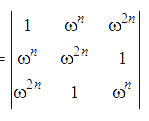If x,y,z are not all zero & if ax+by+cz=0,bx+cy+az=0&cx+ay+bz=0, then prove that x:y:z=1:1:1 OR 1:ω:ω2OR1:ω2:ω , where ω is one ofthe complex cube root of unity.
To prove that x:y:z=1:1:1 or 1:ω:ω2 or 1:ω2:ω, where ω is one of the complex cube roots of unity, we start with the given equations:
1. ax+by+cz=0
2. bx+cy+az=0
3. cx+ay+bz=0
Step 1: Form the Determinant
We can express the system of equations in matrix form and set up the determinant:
∣∣
∣∣abcbcacab∣∣
∣∣=0
Step 2: Calculate the Determinant
Calculating the determinant using the formula for a 3×3 matrix:
=a∣∣∣caab∣∣∣−b∣∣∣bacb∣∣∣+c∣∣∣bcca∣∣∣
Calculating each of the 2×2 determinants:
1. ∣∣∣caab∣∣∣=cb−a2
2. ∣∣∣bacb∣∣∣=bb−ac=b2−ac
3. ∣∣∣bcca∣∣∣=ba−c2
Substituting these back into the determinant gives:
=a(cb−a2)−b(b2−ac)+c(ba−c2)
Step 3: Simplify the Determinant
Expanding this expression:
=acb−a3−b3+abc+abc−c3
Combining like terms results in:
=3abc−(a3+b3+c3)
Setting this equal to zero gives us:
a3+b3+c3−3abc=0
Step 4: Factor the Equation
Using the identity for the sum of cubes, we can factor this as:
(a+b+c)(a2+b2+c2−ab−ac−bc)=0
Step 5: Analyze the Factors
This gives us two cases to consider:
1. a+b+c=0
2. a2+b2+c2−ab−ac−bc=0
Step 6: Case 1: a+b+c=0
If a+b+c=0, substituting x=1,y=1,z=1 satisfies the equations:
a+b+c=0⟹x:y:z=1:1:1
Step 7: Case 2: a2+b2+c2−ab−ac−bc=0
This can be rearranged to:
12((a−b)2+(b−c)2+(c−a)2)=0
This implies a=b=c. If we let x=1,y=ω,z=ω2 (where ω is a cube root of unity), we can also satisfy the equations:
a+bω+cω2=0
Conclusion
Thus, we conclude that:
x:y:z=1:1:1or1:ω:ω2or1:ω2:ω
2. bx+cy+az=0
3. cx+ay+bz=0
∣∣abcbcacab∣∣
∣∣=0
2. ∣∣∣bacb∣∣∣=bb−ac=b2−ac
3. ∣∣∣bcca∣∣∣=ba−c2
2. a2+b2+c2−ab−ac−bc=0
Topper's Solved these Questions
- DETERMINANTS BOOK - ARIHANT MATHS ENGLISHCHAPTER - DETERMINANTS EXERCISE - Determinants Exercise 7:
3 Videos
- DETERMINANTS BOOK - ARIHANT MATHS ENGLISHCHAPTER - DETERMINANTS EXERCISE - Exercise (Questions Asked In Previous 13 Years Exam)
18 Videos
- DETERMINANTS BOOK - ARIHANT MATHS ENGLISHCHAPTER - DETERMINANTS EXERCISE - Exercise (Statement I And Ii Type Questions)
7 Videos
- DEFINITE INTEGRALBOOK - ARIHANT MATHS ENGLISHCHAPTER - DEFINITE INTEGRALEXERCISE - Exercise (Questions Asked In Previous 13 Years Exam)
38 Videos
- DIFFERENTIAL EQUATION BOOK - ARIHANT MATHS ENGLISHCHAPTER - DIFFERENTIAL EQUATION EXERCISE - Exercise (Questions Asked In Previous 13 Years Exam)
26 Videos
Similar Questions
If A=⎛⎜⎝1111ω2ω1ωω2⎞⎟⎠ where ω is a complex cube root of unity then adj−A equals
View SolutionEvaluate ∣∣ ∣ ∣∣1ωω2ωω21ω2ωω∣∣ ∣ ∣∣ where ω is cube root of unity.
View SolutionIf ω is a cube root of unity, then
1+ω= …..
View SolutionProve that the lines ax+by+c=0,bx+cy+a=0andcx+ay+b=0 are concurrent if a+b+c=0 or a+bω+cω2+cω=0 where ω is a complex cube root of unity .
View SolutionProve that the value of determinant ∣∣ ∣ ∣∣1ωω2ωω21ω21ω∣∣ ∣ ∣∣=0
where ω is complex cube root of unity .
View SolutionIf ω is a cube root of unity, then
1+ω2= …..
View SolutionThe common roots of the equation x3+2x2+2x+1=0and1+x2008+x2003=0 are (where ω is a complex cube root of unity)
View SolutionSTATEMENT-1 : If a,b,c are distinct and x,y,z are not all zero and ax+by+cz=0,bx+cy+az=0,cx+ay+bz=0, then a+b+c=0 and STATEMENT-2 : a2+b2+c2>ab+bc+ca, if a,b,c are distinct.
View SolutionIf |z−1|≤2and∣∣ωz−1−ω2∣∣=a (whereωisacubeo√funity) , then complete set of values of a
View SolutionIf 1,ω,ω2 are the cube roots of unity, then △

is equal to.....
View Solution
